- Все статьи 669
-
Подпишитесь, чтобы получать уведомления о публикации новых выпусков
International Journal of Information Engineering and Electronic Business @ijieeb
Статьи журнала - International Journal of Information Engineering and Electronic Business
Все статьи: 669
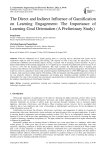
Soepriyatna, Christian Haposan Pangaribuan
Статья научная
With the widespread use of digital gaming, there is a growing need to determine how games and its components might be used for learning and teaching. The majority of study in this topic has taken place in more economically established and developed regions, leaving a research void in emerging country situations. To gain a deeper understanding of the learning engagement, it is of significance to examine the gamification perceived ease of use as well as a dive into the learning goal orientation. This study examines the moderating effect of learning goal orientation that influences the relationship between gamification application and learning engagement. The theoretical model was tested in a quantitative study using structural equation modelling based on a PLS-SEM approach, conducted in Jakarta, with actual local college students. The findings of this investigation noted that gamification perceived ease of use was positively related to learning engagement, and learning goal orientation partially mediated this positive relationship. The value of this research may aid educators and practitioners in determining which factors may influence the adoption of gamification in formal higher education.
Бесплатно
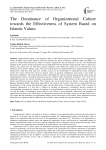
The Dominance of Organizational Culture towards the Effectiveness of System Based on Islamic Values
Syaifullah, Tengku Khairil Ahsyar
Статья научная
Organizational culture is the dominant value or habit that becomes the driving force for an organization. Values, thoughts, and symbols based on Islam that influence the norms of behavior, attitudes, habits, and habits of a person in various fields become the culture of Islamic organizations that are believed to be true. The fundamental problem in this research is that organizations do not understand what the dominant organizational culture is today, how effective the system users are with these cultural conditions, and whether the current level of effectiveness of the dominant culture follows Islamic values. Previous research shows the relationship between organizational culture and effectiveness, while this study adds new variables, and proves the relationship of organizational culture dominance model with system effectiveness based on Islamic values on practical contribution, and creates a new model on theoretical contribution. The research phase begins with finding the current dominant organizational culture using the Organizational Culture Assessment Instrument and the Cultural Values Framework Instrument. Next, look for the relationship between the current dominant organizational culture and the effectiveness of the system by using the Delone and Mclean Is Success Model. Then combine the second model based on Islamic values using Structural Equation Modeling (SEM) - Partial least square (PLS). The result of this research is that there is a relationship between the dominance of the current organizational culture and the effectiveness of information systems. This is because the dominant organization is a clan that is familial in reaching an agreement, commitment between members in communicating, increasing the intensity of members in using information systems, systems that are easy to reach and use, and the quality of information systems that are easy, effective, and accountable. Meanwhile, the dominance of organizational culture on the effectiveness of information systems based on Islamic values has not been fully proven. This means that the dominance of organizational culture on the effectiveness of the Islamic values information system still needs to be adjusted to the four indicators on the Islamic values variable showing the closeness of values.
Бесплатно
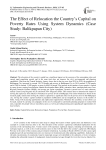
Anzor, Abdul Alimul Karim, Christopher Davito Prabandewa Hertadi
Статья научная
The relocation of the country's capital has a significant impact on the economy of the surrounding cities and caused rapid population growth and at the same time does not improve the city's environmental and planning capabilities. Data from the Central Statistics Agency shows that in the ten years from 2010 to 2020, the population of Balikpapan City increased by around 130,739 people and poverty in Balikpapan City in 2019 reached 15,780 people and in 2020 it reached 17,020 people. as many as 688,318 people. The increase in the number of poor people is caused by many factors, starting from inflation, Human Development Index (HDI), education, labor, unemployment rate, Gross Regional Domestic Product (GRDP), and average per capita expenditure. Dynamic systems have two main elements, namely Causal Loop Diagrams (CLD) and Stock Flow Diagrams (SFD). This research aims to determine the impact of moving the capital city from Jakarta to Nusantara on poverty levels in Balikpapan. The results obtained are based on the research graph, namely that moving the country's capital has a significant effect on the poverty level in the Balikpapan city, moving the country's capital resulted in population mobilization and an insignificant increase in the number of births. Along with increasing opportunities and employment opportunities. Minimize this condition, several efforts can be made, namely by carrying out campaigns on the use of contraceptives and family planning programs to reduce birth rates, especially for people who are classified as poor, as well as providing training and expanding job opportunities for local workers.
Бесплатно
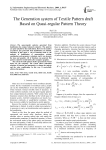
The Generation system of Textile Pattern draft Based on Quasi-regular Pattern Theory
Suyi Liu
Статья научная
The quasi-regular patterns generated from hamiltonian has unique balanced symmetry. The patterns are quite suitable for the textile fabric. However the number of patterns just generated from hamiltonian are limited. Therefore in this paper a 110 of functions built by the methods of hamiltonian of superposition, nesting, combination and parameter variations, and it can increase the type and quantity. All of functions can generate fine patterns suited for textile fabric after computer graphics. The system of textile pattern draft is generated by Visual basics for the computer. The system allows individual selection of function and parameters to change the pattern and the color conditioning. In this way, it successfully achieves the purpose.
Бесплатно
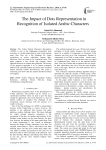
The Impact of Dots Representation in Recognition of Isolated Arabic Characters
Nehad H A Hammad, Mohammed Elhafiz Musa
Статья научная
The Arabic Optical Characters Recognition (AOCR) is one of the challenging recognition tasks nowadays, as Arabic handwriting is cursive and contains many dots. Dots are a big challenge for Arabic recognizers, as writers sometimes connect them. Moreover, Dots are prone to be considered noise. This paper proposes a new divide and conquers based approach that tries to conquer dots problems. The novelty of the proposed approach is in its feature extraction method. The extracted features are used to train Artificial Neural Network (ANN) Feed-forward. The result is interesting and shows that this method should be further investigated.
Бесплатно
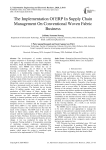
The Implementation Of ERP In Supply Chain Management On Conventional Woven Fabric Business
Julianty Surasma Surung, I. Putu Agung Bayupati, Gusti Agung Ayu Putri
Статья научная
The development of modern technology requires companies to increasingly compete. It does not only apply to big companies but also small companies like Micro, Small and Medium Enterprises (MSME). In Indonesia, most MSME runs without the use of information technology, one of which is the XYZ weaving conventional business. The XYZ Weaving Business is a manufacturing company that produces products in the form of Endek Fabrics and Custom Fabrics. Endek is a term for ikat woven fabric originating from the island of Bali. Endek woven fabric has a variety of unique motifs from sacred to reflect the feel of nature. Meanwhile, custom weaving is a term for woven fabric that has a homemade motif and usually comes from the wishes of the customer. The business has an income above 50 million rupiahs every month with a total production of 2000 meters of fabric, besides, their customers are from companies and individuals. However, their processes are still managed conventionally, resulting in internal problems such as unorganized data and information due to the lack of integration among company divisions. Furthermore, it also results in disrupted service to customers and the company could suffer losses. ERP is a very popular concept to use in companies because it has a functional area that suits the needs of the company. The ERP used in this study is based on Open source, namely Odoo. The results of research with the implementation of Odoo software by using the Sales, Purchase, Inventory and Manufacturing modules resulting in a more integrated business process change. A test was conducted by using the User Acceptance Testing method to 10 respondents consisting of marketing company employees, administrators, material purchases, warehouses, and production. The total score obtained is 713 and is located in the third quarter, which means the system is considered quite successful to be implemented in XYZ Weaving.
Бесплатно

The Implementation of 3D Scene Walkthrough in Air Pollution Visualization
Shigang Wang, Weitao Li
Статья научная
We present a practical and novel approach to implement 3D scene walkthrough for air pollution visualization. This approach includes volume rendering and clipping methods, which are used to visualize large-scale air pollution data. A new viewpoint-based volume clipping method is used while rendering, which is fast and more interactive than previous methods. We achieved expected experimental results and our research could benefit environment monitoring and many other applications associated with pollution visualization.
Бесплатно
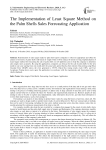
The Implementation of Least Square Method on the Palm Shells Sales Forecasting Application
Fahirah, Lily Wulandari
Статья научная
Determination of sales targets made by palm shell export companies is often not appropriate and effect the amount of inventory of palm shells sold based on weight which will be reduced if stored too long. Implementation of Least Square method for forecasting the sale of palm shells on web platforms aims to help the company to determine sales targets more accurately. By using this application, companies can forecast for the sale of palm shells for the next month in one year starting from one month after the actual sales period that has been entered. Data testing using Mean Absolute Error (MAPE) shows the error generated is 5.935%, Black Box testing results reach 100%, and User Acceptance Testing shows users agree the application in accordance with the requirements and forecasting results is clearly displayed.
Бесплатно
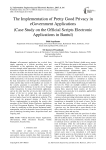
Didit Suprihanto, Tri Kuntoro Priyambodo
Статья научная
eGovernment application has evolved from simply appearing as a website providing news and information, to the application that provides various services through online transactions. Provision of online transactions require the effectively and safely service, so the users can make sure that the entry data is secure and will not be used by other parties which are not authorized. Security is also necessary for the service provider side of online transactions, it is necessary to keep the system, and the data transactions sent through the communications media and the data stored in the database are secured. If the security guarantee is unavailable, the users will gradually lose their confidence to use the service through online transactions by using eGovernment application, and on the other hand the service provider will face the impact of the lost or corrupt data, and unauthorized access to the data which should be only accessed by involved parties based on the appropriate authority. This paper reveals the proposed strategy of Pretty Good Privacy implementation in protecting the security data messages of the Official Scripts Electronic Applications in a Local Government Regency. The proposed strategy is done by modifying on four process document letters’ management, such as an electronic form of incoming mail, print or hardcopy incoming letters, disposition letter, and outgoing mail.
Бесплатно
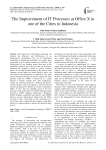
The Improvement of IT Processes at Office X in one of the Cities in Indonesia
Putu Wulan Wahyu Sandhiani, I. Made Sukarsa, I. Putu Agus Eka Pratama
Статья научная
The proper use of information technology can improve the efficiency and effectiveness of an organization’s performance. The use of information technology in educational institutions also require good governance so as to ensure transparency, efficiency, and effectiveness of any business process that runs on the institutions. Audit is one of the ways that can be done to determine the company’s ability to execute business process in it so that the performance of the process in the company can run better and more effective, and it can also improve the performance of employees. The audit process conducted at Office X aims to evaluate the work program using the COBIT 5 framework as a guide because it already contains four main perspectives, namely the customer perspective, financial perspective, internal business process perspective, and the learning and growth perspective. Results of research conducted at Office X show that the capability level of the four processes in the audit which are APO07 (Manage human resources), BAI02 (Manage requirements definition), BAI04 (Manage availability and capacity), and EDM04 (Ensure resource optimization) achieved by the Office still stop at level 1 and there is still a difference of 4 levels from what is expected by the company so that there needs to be improvements to achieve the specified target level 5.
Бесплатно
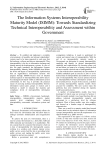
STEFANUS Van Staden, JAMESON Mbale
Статья научная
To establish and implement a workable e-Government, all possible and relevant stakeholders' systems need to be inter-connected in such away that the hardware, software and data are interoperable. Thus, interoperability is the key to information exchange and sharing among the heterogeneous systems. In view of this, the paper introduces the Information Systems Interoperability Maturity Model (ISIMM) that defines the levels and degree of interoperability sophistication that an organisation's Information Systems will progress through. ISIMM focuses more on detailed technical aspects of interoperability that allows data to be exchanged and shared within an information system environment. In this way, it provides the practical means of assessing technical interoperability between information system pairs, groups or clusters and it facilitates a model to measure the maturity and compliancy levels of interoperability information systems.
Бесплатно
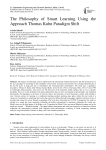
The Philosophy of Smart Learning Using the Approach Thomas Kuhn Paradigm Shift
Azizah. Zakiah, Ary Setijadi Prihatmanto, Dimitri Mahayana, Reza Andrea
Статья научная
The impact of technology must be addressed by the educational methods themselves and their perspectives in the new paradigm of citizenship in this intelligent environment. Learning environments have changed dramatically in the last 50 years, in large part due to information and communications technologies. The study uses a qualitative descriptive. Thomas S. Kuhn, fully Thomas Samuel Kuhn, (born 18 July 1922 in Cincinnati, Ohio, USA-17 June 1996 in Cambridge, Massachusetts), best known for The Structure of the Scientific. Kuhn explains that in every scientific discipline, there are some identified and natural phenomena that are then investigated experimentally and explained theoretically. Pre-paradigm as the basis of normal science, the formation of smart learning is started when primitive cave. Normal science for learning is a traditional teaching method, teaching takes place within the four walls of a classroom. Anomalies are surprising discoveries that cannot be defined through a paradigm, together with discoveries of troubles that cannot be solved through a paradigm. The lock down following the COVID-19 pandemic has made us extrude in a single day from mastering withinside the bodily international to mastering withinside the virtual one. Model crises are the third phase of the Kuhn cycle. Triggering the Model Crisis movement Blended learning can be the brand new normal – “Blended learning”. The smart learning cognizance and traits has emerged as a brand-new fashion withinside the international academic field. different smart technologies, consisting of cloud computing, learning analytics, huge information, Internet of things (IoT) and wearable generation.
Бесплатно
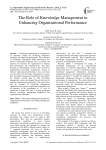
The Role of Knowledge Management in Enhancing Organizational Performance
Abdel Nasser H. Zaied, Gawaher Soliman Hussein, Mohamed M. Hassan
Статья научная
Knowledge management is recognized as an important weapon for sustaining competitive advantage and improving performance. The evaluation of knowledge management (KM) performance has become increasingly important since it provides the reference for directing the organizations to enhance their performance and competitiveness. This paper provides an understanding of factors that involved in implementing knowledge management concept to enhance organizational performance. Also, it provides an assessment tool that helps organizations to assess their knowledge management capabilities and identify the possible existing gaps in their knowledge management systems and suggest the possible ways to enhance organizational performance. The results show that all elements of knowledge management capabilities have a positive significant relationship with all measures of the performance at 1% level of significant; it means that there is a great correlation between knowledge management capabilities and organizational performance
Бесплатно
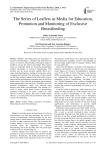
The Series of Leaflets as Media for Education, Promotion and Monitoring of Exclusive Breastfeeding
Debby Yulianthi Maria, Dwi Hariyanti, Bety Agustina Rahayu
Статья научная
Mother's knowledge about the importance of exclusive breastfeeding is a problem that determines the success of exclusive breastfeeding. Information support is needed to increase the mother's knowledge. This research create an acceptable media for increasing breastfeeding mother's knowledge of exclusive breastfeeding. This research uses the action research method. There are 5 stages including diagnosis, making an action plan, acting, evaluating and learning. The informants of this research are the baby mothers, maternal and child health services cadres and the breastfeeding counseling team at the Pleret health centre. Data collection instruments and techniques using questionnaires and interviews. Credibility test with technical triangulation, which was analyzed using theories from Milles and Huberman. The creation of a series of leaflet media about exclusive breastfeeding guidelines consisting of six series. Leaflets are made attractive in terms of design. This series of leaflet media effective as an educational and promotional media about exclusive breastfeeding.
Бесплатно
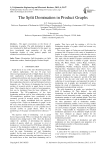
The Split Domination in Product Graphs
K.V. Suryanarayana Rao, V. Sreenivasan
Статья научная
The paper concentrates on the theory of domination in graphs. The split domination in graphs was introduced by Kulli and Janakirm. In this paper; we have investigated some properties of the split domination number of some product graphs and obtained several interesting results.
Бесплатно
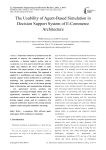
The Usability of Agent-Based Simulation in Decision Support System of E-Commerce Architecture
ŠPERKA Roman, SLANINOVÁ Kateřina
Статья научная
Electronic commerce (e-commerce) has the potential to improve the competitiveness of the enterprises. A decision support system, used in e-commerce, is a term used to describe any software engine that enhances the user’s ability to make decisions. The paper presents a new approach for decision support system modeling. This approach is applied by a modification and extension of existing decision support system architecture by multi-agent technology and agent-based simulation models. Multi-agent technology is one of the fastest growing fields of information and communication technology – new agent-based services, products, and applications are being developed almost every day. Agent-based simulation model is applied to coordinate, control, and simulate the architecture of decision support system, used in e-commerce. The proposed architecture improves the existing decision support systems and gains competitive advantage.
Бесплатно
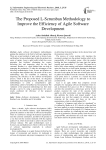
The proposed L-ScrumBan methodology to improve the efficiency of agile software development
Aysha Abdullah Albarqi, Rizwan Qureshi
Статья научная
Agile software development methodologies gaining the attention in the field of software engineering. There are several methods of agile such as Scrum, Lean, and Kanban. Scrum methodology divides the product into series of sprints. Lean is agile toolkit which has seven principles that facilitate: eliminating the wastes, delivering fast, and improving value for the final customer. Kanban is a visual method that can help in managing the production. To take the advantages of the following methodologies: Lean, Scrum, and Kanban we can integrate them together thus, the result will be a new methodology that can contribute in enhancing and improving the efficiency of the software development process, which is the aim of this thesis. An integrated methodology that integrating Scrum, Kanban, and Lean methodologies to yield a comprehensive agile methodology called L-ScrumBan has been proposed. The validation of the proposed methodology has been done through a survey by using a questionnaire; the survey results confirmed the efficiency of the proposed methodology.
Бесплатно
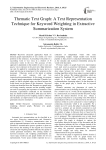
Murali Krishna V.V. Ravinuthala, Satyananda Reddy Ch.
Статья научная
Keyword extraction approaches based on directed graph representation of text mostly use word positions in the sentences. A preceding word points to a succeeding word or vice versa in a window of N consecutive words in the text. The accuracy of this approach is dependent on the number of active voice and passive voice sentences in the given text. Edge direction can only be applied by considering the entire text as a single unit leaving no importance for the sentences in the document. Otherwise words at the initial or ending positions in each sentence will get less connections/recommendations. In this paper we propose a directed graph representation technique (Thematic text graph) in which weighted edges are drawn between the words based on the theme of the document. Keyword weights are identified from the Thematic text graph using an existing centrality measure and the resulting weights are used for computing the importance of sentences in the document. Experiments conducted on the benchmark data sets SemEval-2010 and DUC 2002 data sets shown that the proposed keyword weighting model is effective and facilitates an improvement in the quality of system generated extractive summaries.
Бесплатно
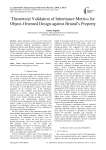
Theoretical Validation of Inheritance Metrics for Object-Oriented Design against Briand's Property
Kumar Rajnish
Статья научная
Many inheritance metrics can be found in the literature, but most of those are validated theoretically by using Weyuker's property. Theoretical validation of inheritance metrics using Briand's property is rare in the literature. This paper considers the metrics proposed by Rajnish and Sandip and presents a theoretical validation of the inheritance metrics using the Briand's size and length properties of an inheritance hierarchy. This paper also gives the projection and viewpoint of the inheritance metrics.
Бесплатно
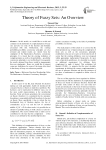
Theory of Fuzzy Sets: An Overview
Mamoni Dhar, Hemanta .K. Baruah
Статья научная
In this article, we would like to revisit and comment on the definition of complementation of fuzzy sets and also on some of the theories and formulas associated with this. Furthermore, the existing probability-possibility consistency principles are also revisited and related results are viewed from the standpoint of the Randomness-Fuzziness consistency principles. It is found that the existing definition of complementation as well as the probability – possibility consistency principles is not well defined. Consequently the results obtained from these would be inappropriate from our standpoints. Hence we would like to suggest some new definitions for some of the terms often used in the theory of fuzzy sets whenever possible.
Бесплатно
- О проекте
- Правообладателям
- Правила пользования
- Контакты
- Разработчик: ООО "Технологии мобильного чтения"
Государственная аккредитация IT: АО-20230321-12352390637-3 | Минцифры России - 2025 © SciUp.org — Платформа публикаций в области науки, технологий, медицины, образования и литературы. "SciUp" — зарегистрированный товарный знак. Все права защищены.

